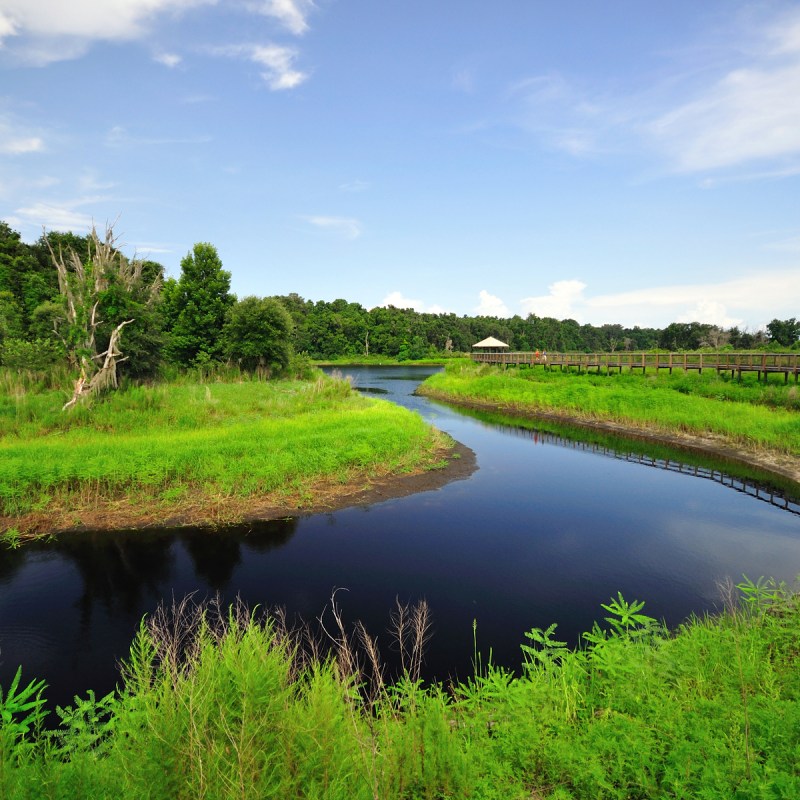
Vacation planning with kids often stumps couples and family groups. What to do and where to go that will get their interest away from texting and TikTok. Florida has some great parks that are sure to excite the whole family. The parks featured here — plus a highly recommended bonus destination at the end — are selected for their appeal to kids 12 and under.
Videos by TravelAwaits

1. DeLeon Springs State Park: Perfect For Breakfast
Pancakes and a refreshing dip in a crystal clear spring-fed pool make for a hard-to-beat combination on a hot summer day.
The most unique attraction at DeLeon Springs State Park is the Old Spanish Sugar Mill Restaurant, where you and the kids cook your own pancakes on a griddle built into the center of the table. The whole grain flour is made from an actual working mill at the restaurant.
The park has three hiking trails, a large freshwater spring for swimming, and rentals for canoes and kayaks. The swimming area has steps leading into the water, making it easy to access for children. The paddle trips on the spring run are in slow-moving, shallow water, which is good for novice paddlers and nervous parents.

2. Blue Spring State Park: Bring On The Manatees
Blue Spring State Park is the home of the herd. Over 150 manatees pack themselves into the spring run from about Thanksgiving until April. The herd size has grown nearly every year for the past decade, and the park is packed with families bringing children to watch the gentle mammals frolic in clear warm water.
Cabin reservations have to be booked months in advance, but campsites are more readily available. The Park sits along the St. Johns River, so the fishing is good. The spring is crystal clear and drops to a depth of about 90 feet, making it a prime scuba spot. There are hiking and mountain bike trails in the nearby St. Francis Wilderness area of the Ocala National Forest.

3. Homosassa Springs State Wildlife Park: Accessibility And Year-Round Manatee Sightings
Is it a zoo? Is it a park? Whatever you want to call it, Homosassa Springs is a place to see hundreds of native Florida animals and critters that have been injured and can’t be returned to the wild. They are all easily visible from boardwalks that wander through the park, making it a great place for kids in strollers and wheelchairs.
Homosassa Springs is the only place in Florida where you can be sure to find manatees year-round. The permanent residents are joined during the colder months by other manatees that migrate into the warm spring waters. There is an underwater observatory where kids can get a close-up look as the manatees drift slowly by.
The animal inhabitants are restricted to native species in need of a place to recover from injuries. They include Key deer, Florida black bear, and pink flamingos.

When still in private ownership in the ’70s and ’80s, the park was home to retired television stars like Flipper, Gentle Ben, and Clarence the Cross-Eyed Lion. The only remaining exotic animal is “Lu,” an African hippo, the oldest hippopotamus in captivity. “Lu” got a waiver of the native wildlife requirement when granted honorary Florida citizenship and permanent park residency by a governor a while back.

4. Paynes Prairie State Park: Horses And Buffalo
Located just south of Gainesville, Paynes Prairie is home to herds of wild horses and buffalo. They roam free and are hard to find at times. You can look for them from the road in your car or take off on a hike on marked trails within the park. If you find them, approach with caution and don’t get too close. They may come to you. Buffalo in particular seem to be curious about humans and may approach you.
There are campsites, nature trails, and even an equestrian trail. (Bring your own horse; you can’t ride the wild ones.)

5. Ichetucknee Springs State Park: Floating Along In Paradise
This north Florida park is known for its crystal clear spring and popular spring run. The fun is in the tubing with the slow current on the river. You can rent tubes at the park’s general store or from private companies that set up along the highway by the park entrance. The river runs for 6 miles, but the north end is too shallow, so tubers take a tram to the launch point about midway down the river. It takes 2-3 hours to tube, and the tram takes you back to the general store.
There is no camping at this park, but you will find nature trails and lots of wildlife. While tubing you may spot otters and beavers. Wild turkeys can be spotted from the nature trail.

6. Silver Springs State Park: Cabins And Wildlife
If you like the idea of the natural vacation experience, but the thought of packing the whole family into a tent for a couple of days causes nightmares and cold sweats, here’s another approach… cabins!
There are only 10 cabins, so reservations may be tough to come by. Book as far in advance as possible. Each cabin has a large screened porch, two bedrooms, a fireplace, and air conditioning.
No trip here is complete without canoeing or kayaking on the sparkling Silver River, one of Florida’s most picturesque paddle trips. There are private outfitters nearby. If you’re lucky you will spot monkeys along the river bank. Their ancestors starred in Tarzan films that were made at Silver Springs decades ago, and were simply released into the wilds when the filming was done.
Silver Springs is a small park in a growing urban area, but there is plenty of wildlife. I’ve seen whitetail deer, a bald eagle, a red-shouldered hawk, and wading birds in abundance. Along the river, we spotted a family of monkeys, river otters, and gators.

7. Florida Caverns State Park: An Underground Adventure
OK, here’s your opportunity to impress the kids. Remember this: stalactites grow from the ceiling, stalagmites grow from the floor.
Florida Caverns is the only place in Florida where you can walk through an underground limestone cavern that dates back 38 million years. The limestone formations grow at the rate of one cubic inch a year, which is roughly equivalent to the speed the kids do their chores around the house. The tour is a gentle walk of about a quarter-mile underground and goes to a depth of 60 feet beneath the surface. The ranger-guided tour lasts 30-40 minutes. No strollers are allowed in the cave, so infants and toddlers have to be carried. Kids have an advantage here. They don’t bump their heads nearly as much as adults do.

8. Bahia Honda State Park: The Best Of The Keys
When Henry Flagler’s Overseas Railroad construction crews got to sun-bathed Bahia Honda Key in the early years of the last century, they stopped. Officially, they were trying to figure out how to span the deepest channel in the Keys. In truth, they just wanted to spend some time hanging out on the Keys’ best beach.
Bahia Honda State Park is an entire island in the middle Keys, just south of the famed “Seven-Mile-Bridge.” The beaches aren’t very wide or very long. The sand was replenished after several hurricanes washed away the old beach a few years ago. But because of the remoteness in the Keys, Bahia Honda’s beach is rarely crowded, even on weekends.
In a way, small makes it perfect for a family with small children. The slope of the beach is indiscernible for nearly a hundred yards into the Atlantic, where the water is barely knee-high on an adult. And there is no pounding surf or tugging currents, thanks to the protection of the off-shore reef. Even in the shallows where the white sand meets the seagrasses, the snorkeling is great and youngsters can watch fish and other small sea critters scurry for cover.
If you want to camp here, book your site well in advance. They usually fill up, especially in the winter.

9. Sebastian Inlet State Park And Turtles
The beaches of Brevard County are among the top turtle nesting areas in the country. Most nesters are loggerheads, but you’ll also occasionally find the rare leatherback and green turtle coming ashore during the summer.
Sebastian Inlet State Park has organized turtle walks at night in June and July, when your chances are good of seeing a loggerhead come ashore and lay her eggs. The free walks are by reservation only and are limited to 25 people. Spaces fill up fast when bookings open in May.
Sebastian also is regarded as the best surfing beach in the state. Bring the boards.

Bonus: Corkscrew Swamp And Its Family-Friendly Boardwalk
This is not a state park, but rather a private preserve northeast of Naples. The National Audubon Society’s Corkscrew Swamp is home to the largest Bald Cypress forest in North America. These huge trees, some of which are more than 600-years-old, soar 130 feet high, and some of the oldest are 25 feet around. They were barely sprouts of cypress knees when Columbus sailed to the new world, and just beginning to develop limbs when Spanish explorers first mapped Florida.
Visitors tour the swamp on a 2.25-mile boardwalk that leads around trees and across wetlands dominated by what park workers call “lettuce lakes.” These are shallow ponds choked with vegetation that serve as wildlife cafeterias. Large alligators dominate the food chain, but Florida black bears and the nearly extinct Florida panther are occasionally spotted in Corkscrew. This is a great bird watching spot with more than 200 species recorded, many of them year-round residents. Bring binoculars and a camera with a good telephoto lens.
The boardwalk makes this a great hike for families with kids in strollers, and you don’t have to worry about youngsters wandering off on their own. There is a shorter boardwalk that runs less than a mile.
Pack the van and get a Florida Atlas and Gazetteer; it’s time for a road trip. Make this the year for some Florida adventures that offer unique eco experiences for the whole family. Just remember to plan ahead and make camping reservations if you want to be sure you get the parks and dates you want.
